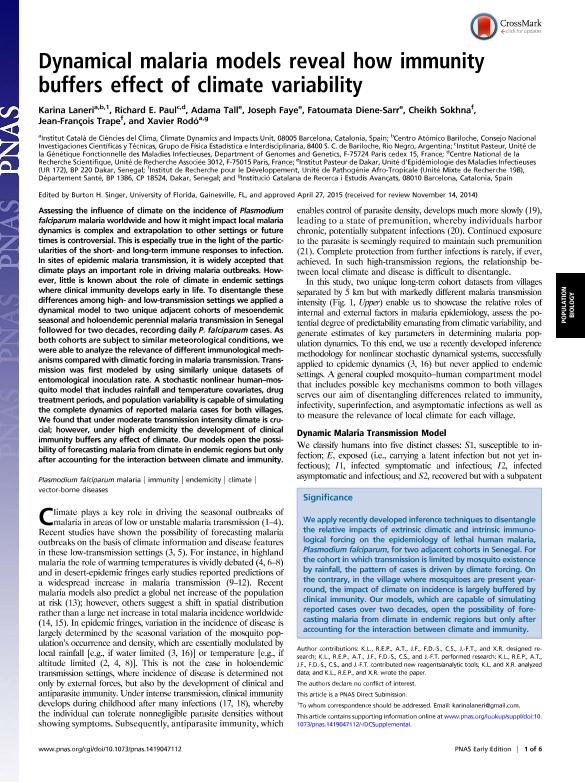Mostrar el registro sencillo del ítem
dc.contributor.author
Laneri, Karina Fabiana

dc.contributor.author
Paul, Richard E.
dc.contributor.author
Tall, Adama
dc.contributor.author
Faye, Joseph
dc.contributor.author
Diene Sarr, Fatoumata
dc.contributor.author
Sokhna, Cheikh
dc.contributor.author
Trape, Jean François
dc.contributor.author
Rodó, Xavier
dc.date.available
2021-03-02T13:21:49Z
dc.date.issued
2015-06
dc.identifier.citation
Laneri, Karina Fabiana; Paul, Richard E.; Tall, Adama; Faye, Joseph; Diene Sarr, Fatoumata; et al.; Dynamical malaria models reveal how immunity buffers effect of climate variability; National Academy of Sciences; Proceedings of the National Academy of Sciences of The United States of America; 112; 28; 6-2015; 8786-8791
dc.identifier.issn
0027-8424
dc.identifier.uri
http://hdl.handle.net/11336/127102
dc.description.abstract
Assessing the influence of climate on the incidence of Plasmodium falciparum malaria worldwide and how it might impact local malaria dynamics is complex and extrapolation to other settings or future times is controversial. This is especially true in the light of the particularities of the short- and long-term immune responses to infection. In sites of epidemic malaria transmission, it is widely accepted that climate plays an important role in driving malaria outbreaks. However, little is known about the role of climate in endemic settings where clinical immunity develops early in life. To disentangle these differences among high- and low-transmission settings we applied a dynamical model to two unique adjacent cohorts of mesoendemic seasonal and holoendemic perennial malaria transmission in Senegal followed for two decades, recording daily P. falciparum cases. As both cohorts are subject to similar meteorological conditions, we were able to analyze the relevance of different immunological mechanisms compared with climatic forcing in malaria transmission. Transmission was first modeled by using similarly unique datasets of entomological inoculation rate. A stochastic nonlinear human-mosquito model that includes rainfall and temperature covariates, drug treatment periods, and population variability is capable of simulating the complete dynamics of reported malaria cases for both villages. We found that under moderate transmission intensity climate is crucial; however, under high endemicity the development of clinical immunity buffers any effect of climate. Our models open the possibility of forecasting malaria from climate in endemic regions but only after accounting for the interaction between climate and immunity.
dc.format
application/pdf
dc.language.iso
eng
dc.publisher
National Academy of Sciences

dc.rights
info:eu-repo/semantics/openAccess
dc.rights.uri
https://creativecommons.org/licenses/by-nc-sa/2.5/ar/
dc.subject
CLIMATE
dc.subject
ENDEMICITY
dc.subject
IMMUNITY
dc.subject
PLASMODIUM FALCIPARUM MALARIA
dc.subject
VECTOR-BORNE DISEASES
dc.subject.classification
Otras Ciencias Físicas

dc.subject.classification
Ciencias Físicas

dc.subject.classification
CIENCIAS NATURALES Y EXACTAS

dc.title
Dynamical malaria models reveal how immunity buffers effect of climate variability
dc.type
info:eu-repo/semantics/article
dc.type
info:ar-repo/semantics/artículo
dc.type
info:eu-repo/semantics/publishedVersion
dc.date.updated
2021-02-26T19:18:00Z
dc.journal.volume
112
dc.journal.number
28
dc.journal.pagination
8786-8791
dc.journal.pais
Estados Unidos

dc.journal.ciudad
Washington
dc.description.fil
Fil: Laneri, Karina Fabiana. Institut Catala de Ciencies del Clima; España. Comisión Nacional de Energía Atómica. Gerencia del Área de Investigaciones y Aplicaciones No Nucleares. Gerencia de Física (cab). División Física Estadística; Argentina. Consejo Nacional de Investigaciones Científicas y Técnicas. Centro Científico Tecnológico Conicet - Patagonia Norte; Argentina
dc.description.fil
Fil: Paul, Richard E.. Institut Pasteur de Paris.; Francia. Centre National de la Recherche Scientifique; Francia
dc.description.fil
Fil: Tall, Adama. Institut Pasteur de Dakar; Senegal
dc.description.fil
Fil: Faye, Joseph. Institut Pasteur de Dakar; Senegal
dc.description.fil
Fil: Diene Sarr, Fatoumata. Institut Pasteur de Dakar; Senegal
dc.description.fil
Fil: Sokhna, Cheikh. Institut de Recherche Pour Le Developement; Senegal
dc.description.fil
Fil: Trape, Jean François. Institut de Recherche Pour Le Developement; Senegal
dc.description.fil
Fil: Rodó, Xavier. Institut Catala de Ciencies del Clima; España. Institució Catalana de Recerca i Estudis Avancats; España
dc.journal.title
Proceedings of the National Academy of Sciences of The United States of America

dc.relation.alternativeid
info:eu-repo/semantics/altIdentifier/doi/http://dx.doi.org/ 10.1073/pnas.1419047112
dc.relation.alternativeid
info:eu-repo/semantics/altIdentifier/url/https://www.pnas.org/content/112/28/8786
Archivos asociados
